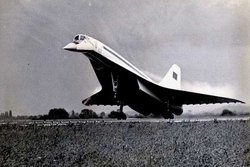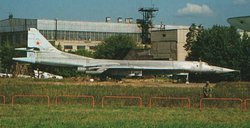Tupolev
|
|
Tupolev (Russian: Туполев) is a Russian aerospace and defence company. Officially known as PSC Tupolev, it is the sucessor of the famed Tupolev OKB or Tupolev Design Bureau (OKB-156, design office prefix Tu) headed by the renowned Soviet aerospace engineer A.N. Tupolev. The company celebrated its 80th anniversary on October 22, 2002.
| Contents |
Introduction
Touchdown.jpg
The capabilities of PSC Tupolev include development, manufacturing and overhaul for both civil and military aerospace products such as aircraft and weapons systems. It is also active in missile and naval aviation technologies. Throughout its existence more than 300 projects have been completed. More than 18,000 Tupolev aircraft were produced for the USSR and the Eastern Bloc.
History
Tupolev OKB was founded by Andrei Nikolayevich Tupolev in 1922. Its facilities are tailored for aeronautics research and aircraft design only, manufacturing is handled by other firms. It undertook research on all-metal airplanes in the 1920s.

Among its notable results during the period was the heavy bomber, where Tupolev's design approach defined for many years the trends of heavy aircraft development, civil and military.
In World War II, the twin-engined, all-metal Tu-2 was one of the best front-line bombers of the Soviets. Several variants of it were produced in large numbers from 1942. During the war it used wooden rear fuselages due to a shortage of metal.
In 1945, four Boeing B-29 Superfortresses landed in Soviet territory after a mission in Japan. They were quickly copied by the design bureau and formed the basis of the first Soviet intercontinental strategic bomber, the Tu-4 (NATO reporting name 'Bull'), which first flew in 1947 and was produced in substantial numbers. The Tu-4 proved critical to Tupolev's postwar development, with many of its most important subsequent aircraft leveraging off of the reverse-engineering of the Boeing aircraft.
This was followed by the development of the jet-powered Tu-16 Badger bomber, based on an enlarged version of the B-29/Tu-4 fuselage, which used a sweptback wing for good subsonic performance.
As turbojets were not fuel efficient enough to provide truly intercontinental range, the Soviets elected to design a new bomber, the Tu-20 'Bear', more commonly referred to as the Tu-95. It, too, was based on the fuselage and structural design of the Tu-4, but with four colossal turboprop engines providing a unique combination of jet-like speed and long range. It became the definitive Soviet intercontinental bomber, with intercontinental range and jet-like performance. In many respects the Soviet equivalent of the Boeing B-52 Stratofortress, it served as a strategic bomber and in many alternate roles, including reconnaissance and anti-submarine warfare.
The Tu-16 was developed into the civil Tu-104, which was for some time the only jet-powered airliner flying following the temporary grounding of the De Havilland Comet. The Tu-95 became the basis of the unique Tu-114 medium-to-long-range airliner, the fastest turboprop aircraft ever.
Even before the first flights of the Tu-16 and Tu-20/Tu-95, Tupolev was working high-speed supersonic bombers, culminating in the unsuccessful Tu-98 (NATO reporting name 'Backfin'). Although that aircraft never entered service, it became the basis for the prototype Tu-102 (later developed into the Tupolev Tu-28 interceptor) and the Tu-105, which evolved into the supersonic Tu-22 'Blinder' bomber in the mid-1960s. Intended as a counterpart to the Convair B-58 Hustler, 'Blinder' proved rather less capable, although ironically it remained in service far longer than the American aircraft. Meanwhile the ?K? Department was formed in the Design Bureau, with the task of designing unmanned aircraft such as the Tu-139 and the Tu-143 unmanned reconnaissance aircraft.
The 1960s also saw the ascendence of A. N. Tupolev's son, A. A. Tupolev. His role includes the development of the world's first supersonic airliner, the Tu-144, the popular Tu-154 airliner and the Tu-22M 'Backfire' strategic bomber, a swing-wing development of the Tu-22. All these developments enabled the Soviet Union to achieve strategic military and civil aviation parity with the West.
In the 1970s, Tupolev concentrated its efforts on improving the performance of the Tu-22M bombers, whose variants included maritime versions. It is the presence of these bombers in quantity that brought about the SALT I and SALT II treaties. Also the efficiency and performance of the Tu-154 was improved, culminating in the efficient Tu-154M.
In the 1980s the design bureau developed the supersonic Tu-160 strategic bomber. Features include variable-geometry wings. The Tu-160 is much more capable than its western equivalent, the Rockwell B-1 Lancer, but the disintegration of the Soviet Union slowed its development, and many early problems were never adequately corrected.
Post Soviet times
With the end of the Cold War, research work was concentrated on subsonic civil aircraft, mainly on operating economics and alternative fuels. The developments include fly-by-wire, use of efficient high-bypass turbofans and advanced aerodynamic layouts for the 21st century transport aircraft such as the Tu-204/214, Tu-330 and Tu-334.
Among current Tupolev projects:
- further development of TU-204/214 and TU-334 aircraft family
- development of cargo aircraft TU-330, regional and executive TU-324 aircraft
- research on practical aspects of aircraft operation using alternative fuels
- modernization of Russian Naval Aviation and Air Force
Directors
- Andrei Nikolayevich Tupolev was a leading designer at the Moscow-based Central Aero-Hydrodynamic Institute (TsAGI) from 1929 until his death in 1972. This design bureau produced mostly bombers and airliners.
- Alexei Tupolev, son of Andrei Tupolev, was also a famous aircraft designer. His most famous design was the supersonic airliner Tupolev Tu-144. He led Tupolev until his death in 2001.
Tupolev aircraft
Many designs have come out from the design bureau. Those in production series may have runs up to 4,500 as in Tu-2. However many are also dead-ends or experimental, with as little as a single copy being produced. They were killed by changing military or political situations. Many of these experimental variants pave the way for series production versions. In the West, Soviet aircraft are better known by their NATO code-names. The code-names are shown where applicable.
Early piston-powered series
- Tupolev ANT-4
- Tupolev ANT-20 Maxim Gorky
- Tupolev ANT-25
- Tupolev Tu-2 "Bat"
- Tupolev Tu-4 "Bull"
- Tupolev Tu-10
Experimental types and dead-ends
- Tupolev Tu-1
- Tupolev Tu-6
- Tupolev Tu-8
- Tupolev Tu-12
- Tupolev Tu-70
- Tupolev Tu-72
- Tupolev Tu-73
- Tupolev Tu-74
- Tupolev Tu-75
- Tupolev Tu-80
- Tupolev Tu-82
- Tupolev Tu-85 "Barge"
- Tupolev Tu-91 "Boot"
- Tupolev Tu-93
- Tupolev Tu-96
- Tupolev Tu-98 "Backfin"
- Tupolev Tu-107
- Tupolev Tu-110
- Tupolev Tu-116
- Tupolev Tu-119
- Tupolev Tu-125
- Tupolev Tu-155
- Tupolev Tu-156
- Tupolev Tu-206
- Tupolev Tu-216
Series bombers and other military types
- Tupolev Tu-14 "Bosun"
- Tupolev Tu-16 "Badger"
- "Bear" line
- Tupolev Tu-20 (erroneous name for Tu-95)
- Tupolev Tu-95 ("Bear A") and modifications
- Tupolev Tu-142 ("Bear F"), anti-submarine
- Tupolev Tu-22 "Blinder"
- Tupolev Tu-22M/Tu-26 "Backfire"
- Tupolev Tu-126 "Moss"
- Tupolev Tu-160 "Blackjack"
Series fighters
- Tupolev Tu-28/Tu-102/Tu-128P "Fiddler"
Series airliners/transport
- Tupolev Tu-104 "Camel"
- Tupolev Tu-114 "Cleat"
- Tupolev Tu-124 "Cookpot"
- Tupolev Tu-134 "Crusty"
- Tupolev Tu-144 "Charger"
- Tupolev Tu-154 "Careless"
- Tupolev Tu-204
- Tupolev Tu-214
- Tupolev Tu-330
- Tupolev Tu-334
Unmanned aircraft
- Tupolev Tu-121 "C"
- Tupolev Tu-123 "Yastreb-1"
- Tupolev Tu-139 "Yastreb-2"
- Tupolev Tu-141 "Strizh"
- Tupolev Tu-143 "Reis"
- Tupolev Tu-243 "Reis-D"
- Tupolev Tu-300
See also
|
Lists of Aircraft | Aircraft manufacturers | Aircraft engines | Aircraft engine manufacturers Airports | Airlines | Air forces | Aircraft weapons | Missiles | Timeline of aviation |
External links
- Company web site http://www.tupolev.ru/English/ (in English)



